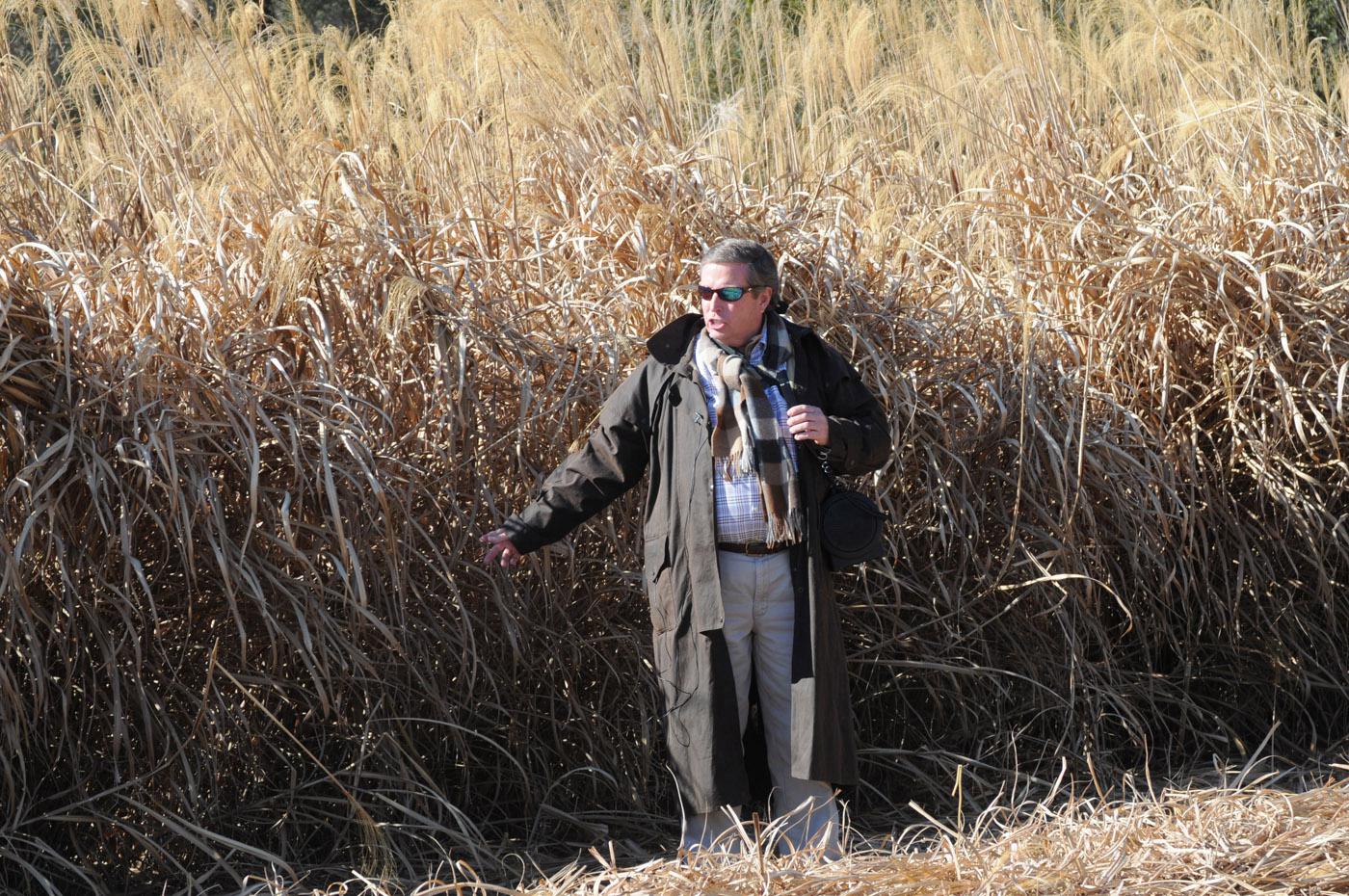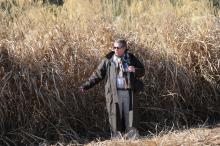Information Possibly Outdated
The information presented on this page was originally released on February 3, 2011. It may not be outdated, but please search our site for more current information. If you plan to quote or reference this information in a publication, please check with the Extension specialist or author before proceeding.
Field day promotes giant miscanthus
By Cheree Franco
MSU Ag Communications
MISSISSIPPI STATE -- On a January morning in Soperton, Ga., southeastern farmers mingled with investors and biomass experts to discuss Freedom Giant Miscathus--a towering grass that may be America’s most promising clean energy solution.
Freedom was developed at Mississippi State University and is licensed exclusively to Repreve Renewables, a joint venture between sod entrepreneur Phillip Jennings and publicly traded textile company UNIFI Manufacturing, Inc.
At the Freedom field day, Repreve representatives outlined the benefits of giant miscanthus while gas prices hovered just under $3 per gallon and Deepwater lawsuits dotted the headlines.
Brian Baldwin, a researcher with MSU’s Agricultural and Forestry Experiment Station, spent over a decade developing Freedom. Tests show that in the mild climate and sandy soils of the southeast, the variety outperforms all other strains of miscanthus.
“Biomass is about tonnage. When you look at the resources needed to grow those tons--the water, input of fossil fuels, planting and harvesting--Freedom looks like it could yield more tons per acre with less input than just about anything we’ve studied,” said Jill Stuckey, the director of Georgia Center of Innovation for Industry.
A perennial grass native to Asia, giant miscanthus has been researched as an energy crop in Europe for 3 decades. It co-powers Drax, the largest coal-fired generator in the U.K. At least a dozen countries are experimenting with miscanthus as biomass.
“If you’re looking for a crop that reaches heights of 10 to 12 feet and you don’t want the 15-year lag time of trees, this is it,” said Baldwin. “In every test I’ve performed or read about, the yield on giant miscanthus is double that of switchgrass.”
In its best year, Baldwin’s plot yielded 20 tons an acre. Research suggests that 25 tons of biomass is roughly enough to power two U.S. households for an entire year.
Giant miscanthus has other advantages, as well. According to Repreve, a single planting can yield up to 20 years of harvest. The species thrives in and even enriches low-grade soil, increases biodiversity by providing animal habitat, and tolerates drought, cold and excessive rain.
Potential U.S. growers have plenty of questions.
“People contact me asking if equipment even exists to harvest such a tall grass,” Jennings said. “Part of why we set up this field day is to show people how to plant giant miscanthus, and that yes, it can be harvested; it can be baled.”
Giant miscanthus reproduces by rhizome division, which means that it won’t become invasive the way fertile-seed strains of miscanthus will. It also means giant miscanthus is more difficult to plant.
“We had field demonstrations. We had presentations from big equipment people, reps from companies like AGCO and Case IH,” said Jennings. “And we have video. So now no one can say, ‘How do you plant that?’ or ‘You can’t get that out of the field.’”
Farmers and investors are concerned about a lack of external buyers. But according to Stucky, the infrastructure is already in place.
“I’m dealing with seven companies right now that turn biomass into transportation fuel,” she said. “These systems can work with any kind of dry biomass, and the companies are actively seeking suppliers.”
“We’ve come a long way in a short time,” said Jennings. “The field day was about getting people together--farmers, government, financiers. We will continue to put money into commercializing this grass. We know a lot more now than we knew a year ago.”
And Jennings wants to know even more.
“I took a product from Mississippi and brought it to Georgia,” he said. “It received an infusion of cash from Wall Street. That cash made its way back to MSU in the form of funding for more development. So the cycle begins: good research equals money, equals more research.”
In addition to the licensing fee and royalties, Jennings recently donated $200,000 to MSU as part of an ongoing grant Repreve set up to further giant miscanthus research.
This grant funds the research of Dinum Perarra, a MSU doctoral candidate, as she works to create even better-performing strains of giant miscanthus. Because these plants are genetic clones, laboratory tissue culturing is the quickest way to induce genetic modification that may result in higher yields.
Jennings also funds the research of MSU master’s candidate Max Gilley, who seeks to identify existing pathogens. Eventually Perarra will use Gilley’s findings to screen her new plants for resistance.
Freedom has sparked interest among a growing collection of investors and entrepreneurs.
Bruce Meyer, of Georgia Clean Energy Solutions, works as a consultant and liaison between growers and end users of miscanthus.
“We are making this economically viable,” he said. “End users go beyond utility companies. They include any energy-intensive business that runs solid-fuel boilers. But for the industry to view this as a viable fuel, there has to be a reliable supply chain. Farmers have to organize and make a commitment to plant enough acres each year to meet a supply contract.”
For now, the industry’s success is partially dictated by government policy. Until 2012, the federal Biomass Crop Assistance Program will offer matching establishment and annual payments to approved growers.
“If you look at legislative clean-energy mandates state-by-state, they reach their peak in the early 20’s. The federal government has mandated the production of 36 billion gallons of renewable fuel by 2022,” said Ronald Smith, CFO of both UNIFI and Repreve. “Right now we have significant demand and not a lot of supply. We’re participating in the market at a premium.”
According to Pew Center, 36 billion gallons is about 7 percent of annual U.S. transportation fuel consumption.
“UNIFI is a publicly traded company,” Smith said. “If we’re participating in this, we have to believe in return. We made this investment because the literature strongly suggests that perennial grasses are going to support world energy demands of the future. And among perennial grasses, Freedom is the best option out there.”





